LibraryIreland.com Publications
Books Ulster Imprint
Below is a selection of titles published under the Books Ulster imprint for LibraryIreland.com.
PRE-FAMINE TO EMIGRATION
The following four titles comprise an informal series of books that take the reader from pre-famine Ireland, through the great hunger to the perilous voyage across the Atlantic and on to life in the New World for the Irish emigrants.
Ireland's Welcome to the Stranger: or, an excursion through Ireland, in 1844 & 1845, for the purpose of personally investigating the condition of the poor
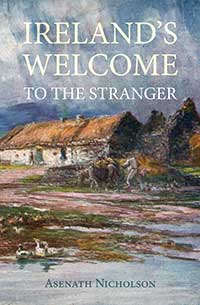
Asenath Nicholson
The value of Ireland's Welcome to the Stranger cannot be overstated. It presents a vivid picture of Irish society on the eve of the Great Famine, exquisitely painted in words by an outsider with a most adept hand. In it we find a remarkable view of Irish life in the 1840s, from the landed gentry down to the poorest peasant, the particular object of the author's visit. The account is all the more valuable and realistic because Mrs Nicholson eschewed staying at the best of hotels and travelling in fine carriages, but more often than not spent her nights in common lodging-houses, or even in the cabins of the poor, and made a great deal of her journey around the country on foot, with an ever-changing cast of peasants for company. On her travels she saw life as it really was for the ordinary folk, witnessed their habits, idiosyncrasies, customs and traditions, from faction fights to funeral laments, and imbibed their mode of speech. In terms of getting a sense of Ireland's social past, her writing is the closest to time travel that could be hoped for.
Asenath Nicholson, a native of Vermont, had for some years run a boarding-house in New York and, in that city, she had become all too familiar with the plight of the poor immigrant Irish. Her first journey to Ireland was inspired by a desire to see for herself the conditions that were causing such a mass exodus. She was teetotal, vegan, anti-slavery and feminist in outlook, but above all an extremely pious woman, who toured the country distributing religious tracts and bibles to the poor. She also had a propensity for impromptu outbursts of hymn-singing which, to her amusement, only added to a notion among the Irish peasantry that she was "crack'd". Here was an intelligent, forceful woman who, with a burning sense of justice and righteous anger, was not afraid to speak her mind, and issued rebukes to those, irrespective of rank or religion, whom she felt fell short of Christian principles and duty.
The combination of the author's ability to write a good narrative, her own personality, and the subject matter that she wrote on, makes this book a gem among gems. It is naturally replete with pathos, but is not without moments of humour too. Sometimes the humour comes deliberately from Mrs Nicholson's pen but, on other occasions, the reader will laugh from the perspective of the subjects of her study at this extraordinary woman, the 'American Stranger'.
A final point is that although the author did travel north, her account confines itself to the more southerly counties:
"Should I ever reach home, I hope to give a fuller detail of my tour, which embraced all but the county of Cavan. I have made no mention of the north of Ireland, for want of room, but cannot close without saying that in Belfast I spent a few pleasant weeks."
This new edition has had the text completely reset and a few obvious spelling mistakes corrected. Notes have been added to those of the author's, with a view to aiding the reader who is perhaps not so familiar with Irish history and social history. Most of the phonetic transcriptions of English word pronunciations should still be easily decipherable, but a few of the less obvious have been annotated. An index has also been added for easier reference, although some repetitive themes throughout the book, such as descriptions of diet and cabin interiors, have been judiciously excluded.
Asenath Nicholson's account of her second tour of Ireland Annals of the Famine in Ireland, in 1847, 1848, and 1849 is also available, ISBN 978-1910375631
Order Ireland's Welcome to the Stranger »
Annals of the Famine in Ireland, in 1847, 1848, and 1849
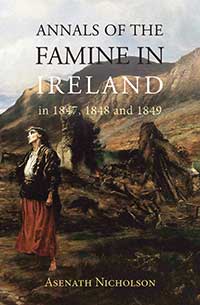
Asenath Nicholson
Annals of the Famine in Ireland is essential reading for anyone who wishes to understand the effects and contributing causes of the Great Famine. But it is not a history. It does not merely trot out facts and figures. Rather, it is a personal and emotional response from an eye-witness to the calamity. Histories are generally detached from the events that they record but, in this account, the reader will experience an immediacy to the situation as though transported back to the very time and place. The anecdotal nature of the testimony allows it to be so.
The author, Asenath Nicholson, was a native of Vermont in the United States. She had previously travelled through Ireland in 1844–45 and graphically described the condition of the Irish poor at that time in her book Ireland's Welcome to the Stranger. She was a teetotaller and a vegan, with a decidedly feminist outlook; she was also ardently anti-slavery and pro animal rights; but first and foremost she was a Christian woman of great piety and all her opinions and actions were coloured by her sincerely-held religious beliefs. When occasion demanded it, Mrs. Nicholson didn’t pull her verbal punches, and those who fell short of her ideal of Christian charity were in grave danger of receiving the sharp edge of her tongue. In the Annals she provides her frank and forthright assessment of government, landlords, relieving officers, and clergy of all denominations. Perhaps not surprisingly, she concludes that indifference, incompetence, mismanagement and corruption among those with influence were all contributing factors to the catastrophe, and suggests that the potato blight in itself need not have led to such widespread starvation and misery.
Here also we receive a valuable insight into the practical realities associated with the famine years—how the dead were disposed of, how the poorhouses operated, the consequences of eviction, proselytism, the inadequacies of Indian meal and 'black bread' as a substitute staple diet, etc. The picture painted is a truly harrowing one, with many scenes of despair and degradation. And it wasn’t only the very poorest at the outbreak of the famine who suffered. Not a few died labouring on their behalf, while others living in relative comfort lost everything in trying to meet the rising taxes that funded such institutions as the poorhouse in which they themselves often ended up. Some, of course, selfishly profited from the tragic situation, and the more unscrupulous landlords took the opportunity to divest their estates of tenantry who no longer had the means with which to pay the rent. Mass emigration, largely to America, was the consequence of it all.
This new edition, with reset text, has had footnotes and an index added for ease of reference. The 'prequel' and companion volume to this book, Ireland's Welcome to the Stranger is also available (ISBN 978-1-910375-62-4).
Order Annals of the Famine in Ireland »
The Ocean Plague: or, A Voyage to Quebec in an Irish Emigrant Vessel
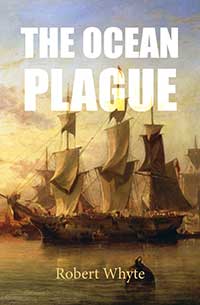
Robert Whyte
The Ocean Plague, first published in 1848, is an account of a voyage from Dublin to Quebec on an Irish emigrant ship. In it we read of the horrific symptoms of disease that so many of the passengers and members of the crew succumbed to. We hear of the decimation of families, the orphaning of children, the practicalities of disposing of the dead, and the callous indifference of many to the suffering of others. And, soberingly, the conditions aboard the vessel in question were without doubt better than those that many Irish emigrants had to endure in other ships. For here, at least, was a captain and his wife who showed genuine concern for those in their care and did what little they could to alleviate the distress of the sick and bereaved.
The author was evidently a man of reasonable means and good education. He had his own berth and dined with the ship’s captain and his wife. However, although Robert Whyte did not have to suffer the same deprivation and misery as his compatriots in the hold, his view of the many dreadful events that befell them is seen through a lens of religious compassion and social conscience, and his diary is nevertheless invaluable eyewitness testimony to the hardship and tragedy experienced on board an Irish ‘famine ship’ in the mid-Nineteenth Century.
Order The Ocean Plague »
The Irish in America
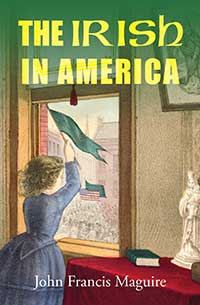
John Francis Maguire
The Irish in America, first published in 1868, provides an invaluable account of the extreme difficulties that 19th Century Irish immigrants faced in their new homeland and the progress which they had nonetheless made in the years since arriving on a foreign shore.
In this substantial volume, the reader will find a sobering description of the fever sheds in the Canadian quarantine quarters of Grosse Isle, details of the heartless ruses employed by rogues to cheat newly-arrived immigrants out of what little they had, a graphic picture of slum life in the tenements of New York, portraits of life for the Irish in the countryside and in the towns, recollections of Irishmen who had fought in the American Civil War, and an account of the progress of the Catholic church in the New World.
In this new, carefully proofed edition, a number of footnotes have been added to those of the author and an 18 page index provided (paperback version only) to supplement the contents and chapter summaries.
Order The Irish in America »
GREAT IRISH FAMINE
‘The Hunger is Upon Us’: Eyewitnesses to the Irish Famine
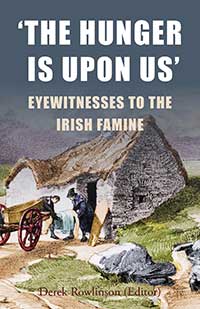
Various Authors
‘The Hunger is Upon Us’ is a collection of eyewitness accounts of the Great Irish Famine, taken from a range of sources, each of which portrays the degree and extent of the catastrophe in terms of human cost. Interspersed throughout the texts are poignant vignettes of the dreadful suffering of individuals, witnessed first-hand by the authors, and never to be forgotten by them.
The book comprises pertinent chapters from W. Steuart Trench’s The Realities of Irish Life, articles from the Adelaide Observer in July, 1847, a Narrative of a Journey from Oxford to Skibbereen (1847) by Lord Dufferin and The Hon. G. F. Boyle, Sketches in the West of Ireland (1847) by the Illustrated London News correspondent James Mahony, reports to the Central Relief Committee of the Society of Friends, and a chapter from Annals of the Famine in Ireland by Asenath Nicholson, a determined American lady who came to aid in the relief effort.
‘The hunger is upon us’ was the cry that two of the reporters for the Central Relief Committee heard constantly as they travelled the country to discover the condition of the Irish poor.The book is complete with index for ease of reference.
Order The Hunger is Upon Us »
The Last conquest of Ireland (Perhaps)

John Mitchel
The Last Conquest of Ireland (Perhaps), first published in 1861, gives John Mitchel’s perspective on the politics and events surrounding the Great Famine, and he is unequivocal in concluding that the catastrophe was as the result of a deliberate policy on the part of the British government to rid Ireland of its excess peasantry. His famous quotation, ‘The Almighty, indeed, sent the potato blight, but the English created the Famine’, comes from this book. Mitchel illuminates not only the horrors of the famine, but the frustrations and absurdities associated with it too as, for example, in food produce leaving Irish ports when so many people in the land were starving. The book also provides a useful insight into the Repeal Association, Young Ireland and the Irish Confederation, with all of which movements John Mitchel was successively involved.
Order The Last conquest of Ireland (Perhaps) »
A Visit to Connaught in the Autumn of 1847: A Letter Addressed to the Central Relief Committee of the Society of Friends, Dublin
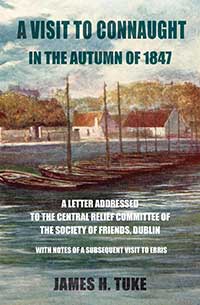
James Hack Tuke
In A Visit to Connaught James Hack Tuke (1819-1896) provides a picture of the condition of the land and people in the province of Connaught at the height of the Great Irish Famine and suggests how both could be improved. His portrait of the state of the Irish peasantry is harrowing and the callous actions of some landlords deplorable. The postscript to the book describes the means and tragic effects of evictions in the County of Mayo.
HISTORY
Fighters of Derry: Their Deeds and Descendants, Being a Chronicle of Events in Ireland during the Revolutionary Period, 1688–91
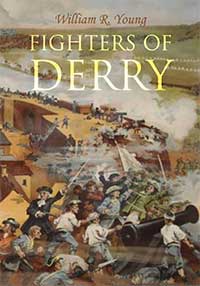
William R. Young
William R. Young's Fighters of Derry has for decades been one of the most overlooked works on the Siege of Derry and as a local genealogical resource. First published in 1932, the book was the product of ten years’ research which the author undertook when suffering from ill-health in the latter part of his life. He died in the following year. His reason for writing it is given in the Preface:
“The history of the great Defence [of Derry] and the honour of the Defenders are safe in such hands [Lord Macaulay and Dr. Witherow]: but it has occurred to me that the present-day generation of Ulstermen, of all political creeds, whether Protestant or Roman Catholic, would be interested in a work giving short sketches of the men who played prominent parts in this great epic and subsequent campaign down to the fall of Limerick, with particulars of their family, antecedents, and present representative. There is scarcely an Ulsterman whose ancestry, direct or through a female line, has not some hereditary touch with participants in those memorable events.”
The book is essentially divided into two parts: the first contains 1660 biographical entries relating to the defenders of Derry and the second has 352 on the Jacobite side, although some merely record the name and regiment or the name alone. Young was a proud Ulsterman and Unionist, but was nevertheless quick to acknowledgement the gallantry of the Irish who fought on the side of King James:
“Though foiled at Derry and beaten at the Boyne (where a gallant Irishman is said to have exclaimed “Change Kings and we’ll fight you again!”), they fought desperately on at Athlone and Aughrim to the walls of Limerick, where they again and again proved the worth of an Irish soldier. There can to-day be nothing but sympathy and admiration for the thousands of Irishmen who, after Limerick, rather than accept extinction in their own land, elected to become exiles and serve in the armies of Spain and France, where the Irish Brigades in many a hard-fought battle proved themselves second to none, while their officers, in many cases, served with such distinction as to found families once ranking among the grandees of Spain, or high in the nobility of other continental countries.”
Apart from individual accounts of eminent protagonists in the siege, such as David Cairnes, Rev. George Walker, the Duke of Schomberg, Patrick Sarsfield, etc., and the not so eminent too, there is also background given to many of the most influential families involved in the conflict.
This new edition provides a short biographical sketch of the author and has been enhanced with illustrations. The index has also been revised and substantially extended.
See also The Actions of the Enniskillen-men (ISBN: 978-1910375068) by Andrew Hamilton which gives an account of the attempted relief of Derry in 1689.
Order Fighters of Derry »
Derry and Enniskillen in the Year 1689: The Story of Some Famous Battle-Fields in Ulster
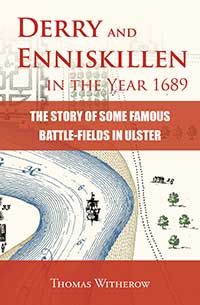
Thomas Witherow
Thomas Witherow's thoroughly researched and well-annotated work is a classic account of the Siege of Derry, from the shutting of the gates against the Jacobite forces by the thirteen apprentice boys to the relief of the city by Major-General Kirke's fleet in July 1689. The defence of Enniskillen and the counteroffensive actions of the Enniskilleners is also ably documented.
Order Derry and Enniskillen in the Year 1689 »
The Actions of the Enniskillen-men
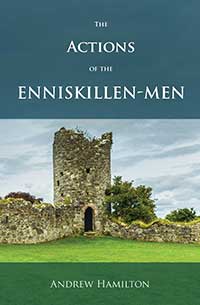
Andrew Hamilton
While the epic siege of Derry is usually accorded its proper place in history, the contemporaneous exploits of the Enniskillen men are often overlooked. This is manifestly unjust because the Enniskilleners demonstrated bravery and heroism in battle at least equal to that of the defenders of Londonderry. Some, of course, rate the actions of the Enniskillen men more highly. As far as Revd Andrew Hamilton, the Rector of Kilskeery and author of A True Relation of the Actions of the Inniskilling Men (1690), was concerned ‘The Derry men saved a city but the Enniskilleners saved a kingdom.’
Order The Actions of the Enniskillen-men »
A Narrative of the Proceedings of the Confederates of '48: From the suspension of the Habeas Corpus Act, to their final dispersion at Ballingarry
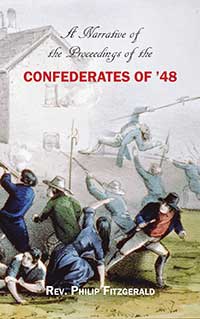
Rev. Philip Fitzgerald
First published in 1868, Confederates of ’48 tells the story of the Young Irelanders’ failed attempt at rebellion against the British which culminated in the ‘Battle of Ballingarry’ (or ‘Battle of Widow McCormack’s Cabbage Patch’) in July 1848. The author, Rev. Philip Fitzgerald was a local priest who was reluctantly persuaded to negotiate between the insurgents and the beseiged police officers inside Widow McCormack’s house. He was later accused of being in league with the rebels, a charge that he strongly denies in his account.
SCOTCH-IRISH IN AMERICA
The Scotch-Irish in America

Henry Jones Ford
The passage of more than one hundred years since The Scotch-Irish in America was first published in 1915 has rendered the book no less fascinating and gripping. Written in a thoroughly accessible way, it tells the story of how the hardy breed of men and women, who in America came to be known as the 'Scotch-Irish', was forged in the north of Ireland during the seventeenth century. It relates the circumstances under which the great exodus to the New World began, the trials and tribulations faced by these tough American pioneers and the enduring influence they came to exert on the politics, education and religion of the country. The author had this to say about the characteristics of the Scotch-Irish:
"Whatever questions be raised as to the controlling heredity in particular cases there can be no question that there is a distinct Scotch-Irish type of frame and physiognomy. It is well known and easily recognized. The long chin gives a characteristic square effect to the lower part of the face. One may notice it in the pictures of Woodrow Wilson as in the pictures of Andrew Jackson. And the race character is as persistent as the physical type. Professor [James] Heron's description of the distinguishing characteristics of the Ulster Scots is applicable also to their kinsmen, the Scotch-Irish in America:
An economy and even parsimony of words, which does not always betoken a poverty of ideas; an insuperable dislike to wear his heart upon his sleeve, or make a display of the deeper and more tender feelings of his nature; a quiet and undemonstrative deportment which may have great firmness and determination behind it; a dour exterior which may cover a really genial disposition and kindly heart; much caution, wariness and reserve, but a decision, energy of character, and tenacity of purpose, which, as in the case of Enoch Arden, 'hold his will and bear it through'; a very decided practical faculty which has an eye on the main chance, but which may co-exist with a deep-lying fund of sentiment; a capacity for hard work and close application to business, which, with thrift and patient persistence, is apt to bear fruit in considerable success; in short, a reserve of strength, self-reliance, courage and endurance, which, when an emergency demands (as behind the Walls of Derry), may surprise the world.
The activity and influence of that race have a securely established importance among the factors of American history."
Henry Jones Ford (1851–1925), was a professor of politics at Princeton University. He wrote a number of books on the political and constitutional history of the United States, as well as a biographical study of his friend, Woodrow Wilson, who was of Scotch-Irish descent.
This new edition, with reset text and revised index, includes a biographical note on the author. The cover image is from the painting Climbing the Western Slope by the American historical artist H. David Wright.
Order The Scotch-Irish in America »
The Scotch-Irish in America
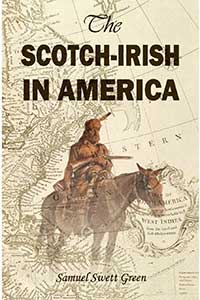
Samuel Swett Green
The Scotch-Irish in America was first delivered as an address to the American Antiquarian Society in 1895 and later published by Charles Hamilton of Worcester, Massachusetts, in the same year. This well-annotated essay provides a clear and informative overview of the history of the Scotch-Irish in north America and includes a useful bibliography of works consulted. As interesting as the address itself is the Appendix, which contains an exchange of rather tetchy correspondence between the author, Samuel Swett Green (a prominent figure in the founding of the American public library system), and Thomas Hamilton Murray, in various newspapers, including the Boston Pilot. Among other matters, Murray took issue with the term “Scotch-Irish”.
Order The Scotch-Irish in America »
SAINT PATRICK
The Epistles and Hymn of Saint Patrick, with the Poem of Secundinus, translated into English
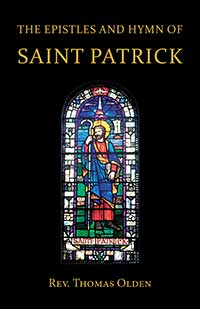
Thomas Olden
Almost 150 years have elapsed between the first publication of The Epistles and Hymn of Saint Patrick and this new edition, but the book has neither lost relevance or accessibility in the intervening time. It can still be read satisfactorily by the layman on one level and by the theological expert on another.
The Introduction provides a very informative background to the subject of St. Patrick and his times, as well as to the individual works included in the book, i.e. the Confessio, the Epistle to Coroticus, St. Patrick’s Hymn and Secundinus’s Hymn – those in Olden’s opinion that have the greatest claim to authenticity when it comes to providing details of the life and nature of the saint.
From the Preface:
“Of the two letters of St. Patrick contained in this work the Confessio was translated and published by the editor in the year 1853, and thus, for the first time, placed within the reach of the general public. In now bringing out a new edition of it, he has been induced to include the letter to Coroticus and the Irish Hymn, which comprise the remaining works of St. Patrick now extant: it seemed also desirable to add the Poem of Secundinus, the nephew and companion of St. Patrick, which contains a most interesting description of him as a missionary.”
Rev. Thomas Olden (1823–1900) was a Church of Ireland clergyman and Vicar of Ballyclough, near Mallow, County Cork.
This second edition has been enhanced with photographs relating to St. Patrick, taken at the church at Saul, County Down, and at Down Cathedral where the saint is reputed to be buried.
Order The Epistles and Hymn of Saint Patrick »
Boulogne-sur-Mer: St. Patrick’s Native Town
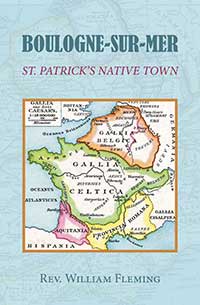
William Fleming
First published in 1907, Boulogne-sur-Mer: St. Patrick’s Native Town provides a case for the Apostle of Ireland having originally come from Armoric Gaul or Britain in France. The author, Rev. William Fleming, strongly refutes the notion that Patrick came from England, Wales or Scotland, citing evidence from what he regards as the most reliable sources, not least the Saint’s own “Confessio.” He believes that the Bonaven Taberniae that St. Patrick refers to in that account – as the place of his father’s residence and from whence Patrick was taken captive – is now known as Boulogne-sur-Mer in Northern France: “Boulogne-sur-Mer, or ancient Bononia, was called by the same name, ‘Bonaven,’ as the town in which St. Patrick implies that he was born. Boulogne possessed a Roman encampment, and it was, therefore, Bonaven Taberniae, mentioned in the ‘Confession.’”
Rev. Fleming was born in Tramore, County Waterford, Ireland, in 1844. He was the author of a number of books, including A Complete Calendar of English Saints and Martyrs (1902) and The Life of St. Patrick, Apostle of Ireland (1905). He also produced an undated booklet entitled St. Patrick’s Birthplace: A Summary of Proofs that the Apostle of Ireland was a Native of Boulogne-sur-Mer, France (Books Ulster, 2020, ISBN 978-1-910375-67-9) He died in London in 1921.
NON-IRISH TITLES
Awful Disclosures of Maria Monk & The Nun; or, Six Months' Residence in a Convent
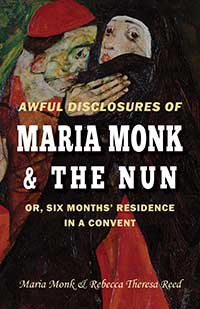
Maria Monk
This volume comprises two books: Awful Disclosures of Maria Monk and The Nun; or, Six Months’ Residence in a Convent by Rebecca Theresa Reed. The former caused a sensation when it was first published in 1836 because Maria Monk claimed to have been a nun in the Hôtel Dieu convent in Montreal where she said she had witnessed torture, rape and murder, including infanticide. She alleged that the children born to nuns as a result of liaisons with priests were baptised, suffocated, and then disposed of in a pit in the nunnery cellar. The accusations were hotly contested and it was stated that Monk had never been a nun at the convent, but rather that she was a prostitute and insane into the bargain. Two inspections were made of the convent which concluded that Monk had never been there, but her adherents insisted that both were ex parte and that the results had been fudged. Arguments over the genuineness of Maria Monk’s disclosures continued to rage for a considerable time and demand for her book was such that numerous editions were produced over the course of the next hundred years.
Six Months in a Convent, published in the previous year to Awful Disclosures, although less lurid in content, was also a source of great controversy. Reed depicted the harsh discipline and practice of deceit in an Ursuline convent on Mount Benedict, Charlestown, Massachusetts, from which she eventually made an escape. The accusations made against the Superior and clergy were flatly denied in her case too, but the controversy refused to die. Some held Reed at least partly responsible for the convent being attacked and burned down by a mob.
In addition to the texts of both books is much further material, including extracts from public journals relating to Maria Monk, additional information on what happened after her alleged escape, the case in her favour, and testimony of others in confirmation of her claims. There is also a supplement to Rebecca Reed’s account.
Among the refutations of Awful Disclosures was The True History of Maria Monk (ISBN: 978-1910375563), first published by the Catholic Truth Society in the late 19th Century.
Order Awful Disclosures of Maria Monk »
Truelove's Journal: A Bookshop Novella
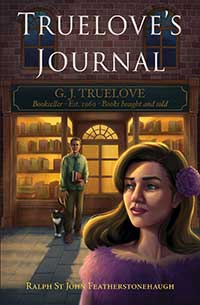
Ralph St. John Featherstonehaugh
The new owner of a shop discovers his predecessor’s journal and embarks on an emotional journey that will change the course of his own life. As he reads the bookseller’s diary he becomes gripped by a compelling curiosity to know more about the man and imbued with the desire to reveal the past of which he never spoke. “Despite the image the outside world may have had of him, Truelove most certainly had his lighter side. I knew from the outset that he was dead, because that was the reason given for the property coming on to the market. It was cruelly frustrating to think that I might have passed him on the street and not known who he was. I also felt a deep sense of regret at never having had occasion to seek out the bookshop when he was still alive. Through his journal I got to know the man in a way surpassed by only one other person, and that story began where the silk bookmark had been placed.”
The enigmatic bookseller, for so long in self-imposed isolation from the rest of humanity, at first finds companionship from an unexpected quarter: “Truelove neither liked nor disliked cats. He had no experience of them on which to form an opinion one way or the other. They were, in fact, really a matter of complete indifference to him. However, although I think it is safe to say that he was not a particularly sentimental man, the bookseller would see neither man nor beast go hungry, and it wasn’t difficult to deduce that this small beast was in want of food.” Truelove’s Journal is a heart-rending story of life, love, and the passion for books.
‘Occasionally one reads a story that is just so beautiful that it leaves a lasting memory. Truelove’s Journal is such a story.’—A review from Amazon.com
